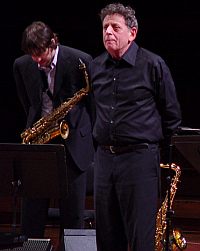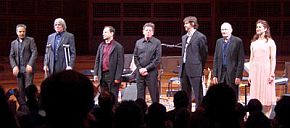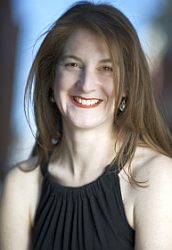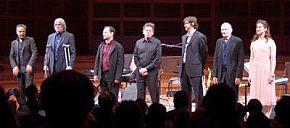
Davies Symphony Hall
By now, Philip Glass is such a familiar aural presence — in a general sense; through operas, recordings, and film scores; and locally, in his frequent Bay Area concerts — that it would seem we know him as well as we’re going to know him. Yet some of his most valuable and significant music remains lesser known, especially in a live context. Thirty-five years after its completion, his magnum opus, Music in 12 Parts, finally received its West Coast premiere Monday, performed by the Philip Glass Ensemble at a packed Davies Symphony Hall under the auspices of San Francisco Performances.
Glass wrote the piece between 1971 and 1974, and it serves as an exhaustive, often exhilarating catalog of his ideas up to the point of its completion, as well as a fanatically complete working-out of each process in his repertoire.
Lasting four full hours, the piece was played with a one-hour intermission, and 10-minute breaks midway through each of its halves. The work was written for the Glass Ensemble’s longstanding instrumentation of three electric keyboards, three amplified winds, and amplified voice. Very generally, each of the 12 parts builds from a brief repeating structure and subjects it to a process of change, often by adding or subtracting bits of each figure as it evolves, and doing this over long stretches of time within a dense contrapuntal texture.
Although each part has a single-minded focus on a particular idea, the piece holds a variety of moods. Part 1 offers a slow and lovely greeting, with its continuous suspensions and spacious feeling; Part 2 is filled with rapid resolutions of its circling figures and then their rhythmic elongation and contraction; in Part 3 the textures turn more dense and the rhythms more chugging; and so on.
Because of the music’s almost unyielding continuity, if you were to take a vertical slice of the music at virtually any point, you’d find yourself in the midst of a thick, blocklike texture. But in its constant layering of lines, it dances, charges, trots along, and forms a marvelous tapestry of interlocking lines as figures appear, evolve, and dissolve into each other.
Most of the piece is fiercely adherent to tonal or modal strictures, but chromaticism emerges as a stronger element in the work’s second half, and a surprise appears in Part 12, where the human voice really takes the lead, with gradually elongating vocal lines that, though sometimes interrupted by more static instrumental passages, are supported by chromatically linked chord progressions. Here, after driving his early, severe concepts as far as they could go, is a premonition of Glass’ turn to opera, with dramatic contrasts, heroic chord progressions, a return to chromatic harmony, and, naturally, the voice in the forefront, ultimately leading to more-traditional ideas of musical expressiveness.
Freeform Listening

Over the course of the piece, an audience member can find many ways to listen, whether by simply enjoying the textures and the interweaving of lines, or by taking pleasure in the superb level of ensemble that the group has achieved. A listener can also attempt to focus on a single figure, listen to it evolve, and then hear it merge with other elements in the mix. Since most of the time there’s no real distinction between foreground and background, and the ensemble is so tight, it’s often impossible to know whether you’re really listening to a single line, whether your ear has jumped to a different musician performing a related line, or whether what’s bubbling to the surface may be a composite of two or more parts.
In this play of perception, the singing produces its own odd effect. The vocal part is all in solfege syllables, though they occasionally seem to morph into phantom phrases; “comme ci, comme ça” and “Mercy, mercy” both played in my head, and during breaks I overheard other audience members discussing the words they thought they’d heard.

Although one or two glances or furrowed brows among the players suggested there might have been a mistake or a lost place among the thousands of repeating figurations, to my ear the performance sounded just about flawless. The ensemble playing was remarkably cohesive and focused, with high and unwavering energy.
In the course of developing this work’s musical language, Glass was also forming a performing aesthetic dependent on amplification; the high-volume power of the music, including the nasal bite of the ’60s-style electric organ sound the Ensemble has stuck with, is part of its unique appeal. With its often racing tempos, knuckle-busting figures, and sheer decibel level, the group put the piece across with a thrilling, raucous precision that is truly unlike that of any other music.
It’s also remarkable that this ensemble is now 40 years old, and, in Glass and flutist/saxophonist Jon Gibson, still includes two founding members. Within this stellar group, praise has to go to the wonderfully fluent singing of Lisa Bielawa, who handled the work’s huge demands with unfailing aplomb. The ensemble also included woodwind players David Crowell and Andrew Sterman, sound mixers Dan Dryden and Stephen Erb (always credited as being equal members of the ensemble), and keyboardists Mick Rossi and Michael Riesman, the Ensemble’s longtime music director. Riesman was on crutches but seemed none the worse once he was at the keyboard, leading this formidable performance.

